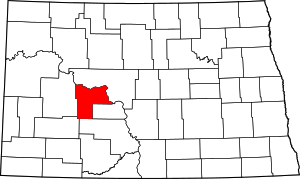Golden Valley, North Dakota
Golden Valley is a city in Mercer County, North Dakota, United States. The population was 182 at the 2010 census.[5] Golden Valley was founded in 1913.
Golden Valley, North Dakota | |
|---|---|
 Location of Golden Valley, North Dakota | |
| Coordinates: 47°17′30″N 102°4′4″W | |
| Country | United States |
| State | North Dakota |
| County | Mercer |
| Area | |
| • Total | 0.75 sq mi (1.94 km2) |
| • Land | 0.75 sq mi (1.94 km2) |
| • Water | 0.00 sq mi (0.00 km2) |
| Elevation | 1,955 ft (596 m) |
| Population | |
| • Total | 182 |
| • Estimate (2019)[3] | 163 |
| • Density | 217.91/sq mi (84.08/km2) |
| Time zone | UTC-7 (Mountain (MST)) |
| • Summer (DST) | UTC-6 (MDT) |
| ZIP code | 58541 |
| Area code(s) | 701 |
| FIPS code | 38-31180 |
| GNIS feature ID | 1029155[4] |
The city should not be confused with the Golden Valley County.
Geography
Golden Valley is located at 47°17′30″N 102°4′4″W(47.291648, -102.067771).[6]
According to the United States Census Bureau, the city has a total area of 0.73 square miles (1.89 km2), all of it land.[7]
Demographics
| Historical population | |||
|---|---|---|---|
| Census | Pop. | %± | |
| 1920 | 369 | — | |
| 1930 | 294 | −20.3% | |
| 1940 | 400 | 36.1% | |
| 1950 | 339 | −15.2% | |
| 1960 | 286 | −15.6% | |
| 1970 | 235 | −17.8% | |
| 1980 | 287 | 22.1% | |
| 1990 | 239 | −16.7% | |
| 2000 | 183 | −23.4% | |
| 2010 | 182 | −0.5% | |
| Est. 2019 | 163 | [3] | −10.4% |
| U.S. Decennial Census[8] 2018 Estimate[9] | |||
2010 census
As of the census[2] of 2010, there were 182 people, 92 households, and 54 families residing in the city. The population density was 249.3 inhabitants per square mile (96.3/km2). There were 117 housing units at an average density of 160.3 per square mile (61.9/km2). The racial makeup of the city was 97.3% White, 1.1% Native American, 1.1% Asian, and 0.5% from two or more races. Hispanic or Latino of any race were 1.6% of the population.
There were 92 households, of which 14.1% had children under the age of 18 living with them, 50.0% were married couples living together, 6.5% had a female householder with no husband present, 2.2% had a male householder with no wife present, and 41.3% were non-families. 38.0% of all households were made up of individuals, and 15.3% had someone living alone who was 65 years of age or older. The average household size was 1.98 and the average family size was 2.57.
The median age in the city was 50.2 years. 17% of residents were under the age of 18; 3.2% were between the ages of 18 and 24; 19.7% were from 25 to 44; 40.6% were from 45 to 64; and 19.2% were 65 years of age or older. The gender makeup of the city was 50.5% male and 49.5% female.
2000 census
As of the census of 2000, there were 183 people, 91 households, and 51 families residing in the city. The population density was 253.2 people per square mile (98.1/km2). There were 124 housing units at an average density of 171.6 per square mile (66.5/km2). The racial makeup of the city was 99.45% White, and 0.55% from two or more races.
There were 91 households, out of which 18.7% had children under the age of 18 living with them, 46.2% were married couples living together, 9.9% had a female householder with no husband present, and 42.9% were non-families. 37.4% of all households were made up of individuals, and 19.8% had someone living alone who was 65 years of age or older. The average household size was 2.01 and the average family size was 2.63.
In the city, the population was spread out, with 17.5% under the age of 18, 4.9% from 18 to 24, 20.2% from 25 to 44, 31.7% from 45 to 64, and 25.7% who were 65 years of age or older. The median age was 47 years. For every 100 females, there were 98.9 males. For every 100 females age 18 and over, there were 104.1 males.
The median income for a household in the city was $27,188, and the median income for a family was $39,688. Males had a median income of $38,125 versus $15,625 for females. The per capita income for the city was $14,783. Approximately 18.4% of families and 20.7% of the population were below the poverty line, including 35.1% of those under the age of eighteen and 7.8% of those sixty-five or over.
References
- "2019 U.S. Gazetteer Files". United States Census Bureau. Retrieved July 27, 2020.
- "U.S. Census website". United States Census Bureau. Retrieved June 14, 2012.
- "Population and Housing Unit Estimates". United States Census Bureau. May 24, 2020. Retrieved May 27, 2020.
- "US Board on Geographic Names". United States Geological Survey. October 25, 2007. Retrieved January 31, 2008.
- "2010 Census Redistricting Data (Public Law 94-171) Summary File". American FactFinder. United States Census Bureau. Retrieved May 2, 2011.
- "US Gazetteer files: 2010, 2000, and 1990". United States Census Bureau. February 12, 2011. Retrieved April 23, 2011.
- "US Gazetteer files 2010". United States Census Bureau. Retrieved June 14, 2012.
- "U.S. Decennial Census". Census.gov. Retrieved June 1, 2013.
- "Population Estimates". United States Census Bureau. Retrieved September 10, 2019.
